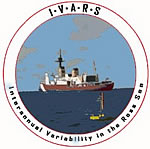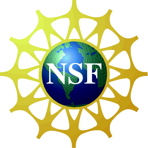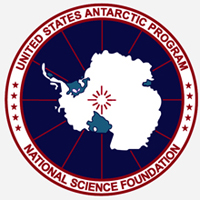About IVARS
What is the overall goal of the IVARS project?
The goal of IVARS is to quantify the year-to-year variability of an Antarctic coastal system, explain its causes, and understand how it affects food webs and biogeochemical cycles in the Ross Sea.
What is the significance of the IVARS project?
Knowledge of year-to-year variability in the Ross Sea throws light on the dynamics of polar coastal ecosystems, and is key to detecting and understanding the significant physical and biological changes predicted to occur in polar areas as global climate warms. Lessons learned in the coastal waters of Antarctica also have direct relevance to understanding coastal ecosystems elsewhere around the world, including the Virginia bight and Chesapeake Bay.
What is the specific focus of IVARS?
The IVARS project focuses on a poorly studied aspect of inter-annual variability in the Ross Sea— the year-to-year variations in primary productivity by phytoplankton and how this variability impacts the food web. IVARS researchers will focus on variations in productivity between the two major phytoplankton groups in the Ross Sea: diatoms and Phaeocystis antarctica, a colonial haptophyte. Both diatoms and P. antarctica are single-celled, photosynthetic algae. They differ in that diatoms build an outer shell of silica and lack flagella, whereas P. antarctica lacks an outer shell and has flagella at one stage of its life cycle. Both groups are critical components of the Antarctic marine food web. They nourish larger organisms, including fish, marine mammals, and penguins, and during photosynthesis take up carbon from atmospheric carbon dioxide that has dissolved in seawater. If this carbon subsequently sinks to the deep sea, it will contribute nothing to global warming and can remain there for thousands of years.
Why the Ross Sea?
The Ross Sea provides a unique setting for the IVARS project. Research there during the past decades provides a background record of seasonal and year-to-year changes in basic physical and chemical processes, including the distribution of sea ice. The Sea's relatively low species diversity reduces the complexity of food-web analyses, and its high seasonal production provides a readily observable signal.
What is the IVARS research plan?
The IVARS project involves two short cruises per year on US Coast Guard icebreakers: one in mid- to late-December (during the "spring bloom"), and one in mid-February (at the end of the growing season). Cruises are scheduled to visit the same sampling sites during each of the project's five years. By comparing data from each cruise to that of "pre-bloom" water (found prior to phytoplankton growth early in the growing season), IVARS researchers can calculate seasonal productivity and compare it to that of previous years, thereby revealing year-to-year changes.IVARS researchers also deploy two moorings during the December cruise, each with an elaborate suite of instruments designed to continuously sample the surface layer to reveal short-term variations within each growing season. The instruments are a fast repetition rate fluorometer (FRRF), a nitrate analyzer, a silicic acid analyzer, a whole-water sampler, two additional fluorometers, a sediment trap, thermistors, a CTD, and current meters. They retrieve these moorings during the second cruise.
What do the sampling instruments record?
The fast repetition rate fluorometer helps assess how the availability of inorganic nutrients such as iron limits phytoplankton growth. Iron becomes limiting in the austral summer, although the extent and onset of this limitation is unknown. Diatoms are considered to be more strongly iron limited than other species, but it is uncertain if this is true in the Ross Sea. A better understanding of iron limitation in the Ross Sea and surrounding areas is crucial given recent proposals to mitigate global warming by boosting phytoplankton growth in the Southern Ocean by "fertilizing" the ocean surface with iron.
The in-situ nitrate analyzers will collect an Antarctic first—time-series of nutrient concentrations in the euphotic zone during an entire growing season. The silicic acid measurements will provide estimates of diatom productivity. Moreover, the ratio of nitrate:silicate uptake is another indicator of iron stress in diatoms.
The sediment traps measure the recycling of organic material as it sinks through the water column. The traps are moored in mid-water to catch the constant rain of organic detritus produced by plankton and other organisms at the sunlit surface. By comparing trap measurements with productivity and biomass estimates, IVARS researchers can calculate export from the surface layer, and thereby throw light on year-to-year changes in this ecosystem process. The speed of sinking particles is important to the global carbon cycle. Small particles sink slowly, allowing bacteria to recycle the carbon they contain back into the surface ocean and atmosphere. More massive particles, formed by larger phytoplankton species and zooplankton, can sink to the depths relatively quickly, removing carbon from the surface ocean and atmosphere, thus slowing the atmospheric build-up of the greenhouse gas carbon dioxide.
The moorings are located where the two different phytoplankton assemblages typically occur. The first mooring (Calinectes), located north of Ross Island, is normally dominated by diatoms. The second (Xiphias) is dominated by Phaeocystis antarctica. Comparisons between the two moorings helps reveal the different roles these two phytoplankton types play in the local food web and biogeochemical cycles.
How do IVARS researchers reach Antarctica?
IVARS scientists typically travel from the U.S. to Antarctica by flying via Los Angeles to Christchurch, New Zealand or Hobart, Tasmania, and then either flying aboard a LC-130 or C-141 cargo plane to McMurdo Station, or sailing to McMurdo across the Southern Ocean. The NZ-McMurdo flight takes 5-8 hours. The Southern Ocean transit typically takes about 8 days. Once the ship arrives at the ice edge, scientists are often ferried to and from McMurdo by helicopter. McMurdo serves as the base station for IVARS cruises to the Ross Sea.
 |
 |
 |

